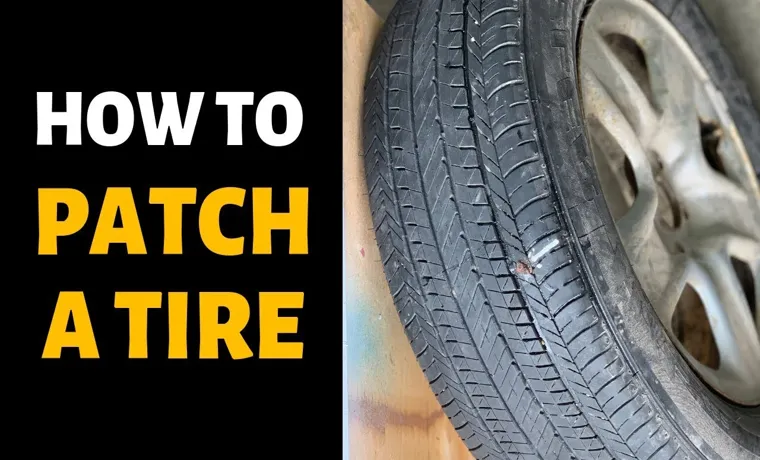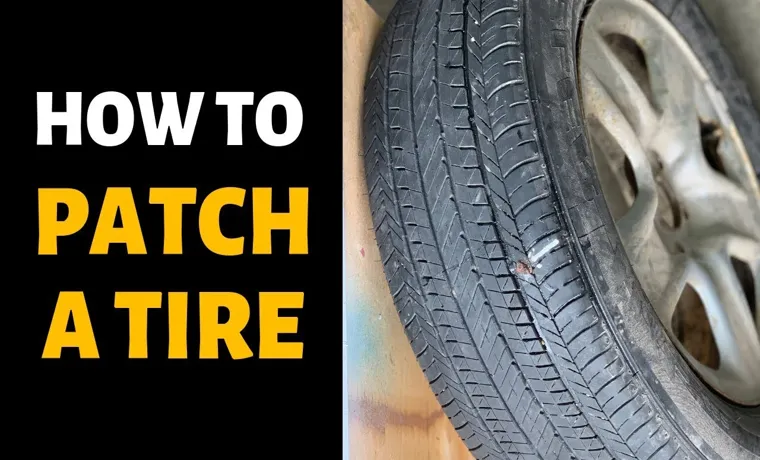As car owners, we all dread the inevitable need for tire repairs. Whether it’s a small puncture or a larger gash, getting a flat tire is not only inconvenient but can also put a dent in our wallets. That’s why it’s important to understand the cost and other important information when it comes to tire patching.
Knowing what to expect can help us make informed decisions and potentially save us money in the long run. So, how much does tire patching cost? And what factors should we consider before getting our tires patched? Let’s explore these questions and more in this informative blog on tire patching.
Table of Contents
What Is Tire Patching?
If you’re wondering how much it costs to get a tire patched, the price varies depending on the location and the type of repair needed. Sometimes, a tire can be patched for as little as $10-20, while more complex repairs like a sidewall puncture can cost closer to $100 or more. Tire patching is a process that involves removing the tire from the wheel and locating the puncture or damage before applying a specialized patch and sealant to fill in the hole.
This can be a cost-effective way to extend the lifespan of your tire and avoid having to replace it altogether. However, it should be noted that not all punctures can be patched; if the damage is too severe or located in an unsafe area of the tire, a replacement may be necessary. It’s always a good idea to have a professional assess the damage and recommend the best course of action to ensure your safety and the longevity of your tires.
Understanding the Process of Patching Tires
Tire patching is the process of repairing a punctured tire by sealing the hole from the inside. This can be done using a rubber patch that adheres to the inside of the tire and covers the hole. It is a common method of repairing minor punctures that haven’t caused too much damage to the tire.
Patching is a cost-effective and convenient alternative to replacing a tire completely, especially when the treads are still in good condition. However, it’s important to note that not all punctures can be patched, and it’s best to take your tire to a professional to assess the damage and determine whether patching is a viable option. Additionally, it’s crucial to ensure that the patch is installed correctly to prevent further damage or potential blowouts in the future.
Next time you find yourself with a flat tire, consider patching as an option before rushing to replace the entire tire.

Why Do You Need To Get Tires Patched?
Tire patching is the act of repairing a punctured tire with a rubber patch glued onto the inner lining of the tire. It is considered a faster and cheaper alternative to replacing an entire tire. The process begins with removing the tire from the rim and finding the puncture site.
Once located, the puncture is cleaned and roughened up to ensure proper adhesion of the patch. Then, a rubber patch is applied to the tire’s inner lining, sealing the puncture and preventing air from escaping. Finally, the tire is reassembled and properly inflated to its recommended level.
Patching tires is essential for several reasons. Firstly, it can extend the life of your tire by preventing unnecessary wear. Secondly, a patched tire can save you money, replacing your tire can be pretty expensive.
Lastly, driving on a damaged tire can be dangerous as it can cause accidents, tire blowouts, and even leave you stranded on the side of the road. Patching a tire is always a better option than driving on a damaged one. In summary, tire patching is vital for the longevity of your tire, your safety, and your wallet.
If you’re unsure whether or not your tire needs patching, consult a tire specialist for advice. Remember, catching a puncture early on can prevent further damage, save you money, and keep you safe while driving.
Cost of Tire Patching
If you’re wondering how much to get a tire patched, the cost can vary depending on a few factors. One major factor is whether the tire needs to be completely replaced or if it can simply be patched. A patch can be a more affordable solution if the damage is minor and located on the tread.
On average, you can expect to pay between $10 and $30 for a tire patch. However, if the damage is more severe or located on the sidewall, the tire may need to be replaced entirely, which can cost significantly more. Additionally, the cost can vary depending on where you go to have the patch done.
Some tire shops may offer the service for free, while others may charge more. It’s important to shop around and compare prices to ensure you’re getting a fair deal. With some research and a little bit of patience, you can get your tire patch at an affordable price and get back on the road with peace of mind.
Factors That Affect the Cost of Tire Patching
Tire patching is one of the cost-effective solutions to fix a punctured tire. However, the cost of tire patching varies depending on different factors. The most significant factor that affects the cost of tire patching is the damage caused to the tire.
If the tire suffers a small puncture on the surface of the tread, it is more likely to be patched quickly and at a lower cost. On the other hand, if the tire has extensive damage or a puncture near the sidewalls, it may require a more comprehensive repair, including the replacement of the tire. In addition to the damage, the size of the tire and the location of the service center could also impact the cost of the repair.
Larger tires, such as those used on trucks and SUVs, will typically cost more to repair than smaller, standard car tires. Finally, the location of the service center could affect the cost as different service centers have varying rates for their service. In general, the cost of tire patching is still more affordable compared to buying a new tire, which is why it is a popular choice among motorists.
Average Cost of Tire Patching
Tire patching is a common method used to repair minor damages to a tire. The average cost of tire patching ranges from $10 to $30 per tire. However, prices can vary depending on the location and severity of the damage.
If the damage is too severe or located in an area that cannot be patched, the tire may need to be replaced, which can cost significantly more. It’s important to have your tires inspected regularly by a professional to catch any potential damages before they become too severe. In addition to saving money on costly tire replacements, maintaining healthy tires can also improve overall safety while on the road.
So, next time you notice a small puncture in your tire, consider getting it patched before it’s too late!
How to Find the Best Deal for Tire Patching?
When it comes to tire patching, the cost can vary depending on a few factors. The first thing you should consider is whether you want to patch the tire yourself or have it done professionally. If you have experience with patching tires, then doing it yourself may be the more cost-effective option.
However, if you are not confident in your abilities, it’s best to take it to a professional. The cost of a professional tire patch can also vary depending on where you go. It’s always a good idea to shop around and compare prices from different tire shops before making a decision.
Additionally, some shops may offer deals or discounts on tire patching, so it’s worth checking their websites or calling to ask. Overall, the best way to find the best deal for tire patching is to do your research and compare prices from different sources before making a decision.
Finding a Professional Tire Patching Service
If you are struggling with a flat tire and wonder how much it will cost to get it patched, the good news is that tire patching services are affordable. On average, it can cost anywhere between $10 to $30 to get a tire patched, depending on the severity of the damage and where you live. However, keep in mind that if the damage is too severe or if the tire is too old, patching may not be an option, and you may need to replace the tire altogether.
It’s essential to find a professional tire patching service that you can trust. Look for a business that has experience in tire repair and a good reputation. Ask friends and family for recommendations and read online reviews.
By doing your research and getting a fair price for the service, you can get back on the road safely and confidently with your newly patched tire.
How to Choose the Right Tire Patching Service?
Choosing the right tire patching service can be a daunting task, especially when there are so many options available. However, finding a professional tire patching service is essential for ensuring the safety of your vehicle. When searching for a tire patching service, make sure to look for professionals who have experience handling tires of all sizes and types.
A good tire patching service should also have a broad range of tools and equipment to repair any tire damages efficiently. Moreover, you must opt for a service that can provide a quick response time and is available round the clock. By choosing a reliable and experienced tire patching service, you can rest easy knowing that your vehicle is in good hands.
What to Look for When Choosing a Tire Patching Service?
When it comes to choosing a tire patching service, there are a few important factors to consider. First and foremost, make sure the service you choose is professional and experienced in tire repair. Look for a company that uses high-quality materials and techniques to ensure the longevity of your tire patch.
It’s also important to consider the range of services offered by the company, including emergency repair options and mobile services. Additionally, check customer reviews and ratings to get a sense of the company’s reputation and customer satisfaction. Most importantly, choose a service that you trust and feel comfortable working with.
By finding a reliable tire patching service, you can ensure your safety on the road and avoid any potential issues down the line.
Conclusion
In conclusion, the cost to get a tire patched varies depending on where you go and what type of tire you have. It’s like a game of roulette – you never know what price you’re going to get. But hey, at least with a patched tire you can keep your wheels rolling and avoid any unforeseen blowouts on the open road.
So, take a chance and seek out the best deal, because in the end, it’ll be worth it to keep your car cruising safely and smoothly.”
FAQs
What is the average cost to get a tire patched at a mechanic shop?
The cost of getting a tire patched can vary depending on the mechanic shop and the severity of the damage, but an average cost range falls between $20 to $40.
Is it safe to drive with a patched tire?
Yes, it is generally safe to drive with a patched tire as long as the repair is done properly and the damage is not too severe. However, it is important to have the tire inspected regularly to ensure its continued safety.
Can I patch a tire myself?
While it is technically possible to patch a tire yourself using a tire repair kit, it is not recommended unless you have experience and proper training. It is best to have a professional mechanic handle the repair to ensure it is done correctly.
How long does it take to patch a tire?
The time it takes to patch a tire varies depending on the severity of the damage and how busy the mechanic shop is. In most cases, it can take anywhere from 15 minutes to an hour.
What types of damage can a tire be patched for?
A tire can be patched for most types of punctures or small cuts, including nails, screws, or glass shards. However, if the damage is too severe or is located on the sidewall of the tire, it may not be able to be patched and the tire may need to be replaced.
Can a tire be patched multiple times?
It is generally recommended to only patch a tire once, as the integrity of the tire can become compromised with multiple repairs. If the tire experiences additional damage, it may need to be replaced.
Does getting a tire patched affect the tire’s performance or lifespan?
Getting a tire patched should not significantly affect the tire’s performance or lifespan if the repair is done properly. However, as with any repair, it is important to monitor the tire for any signs of continued damage or wear and tear.



